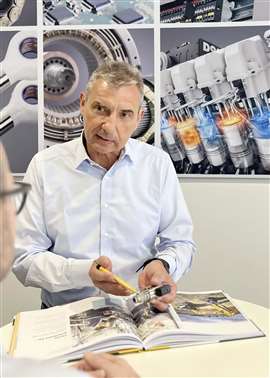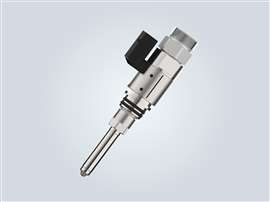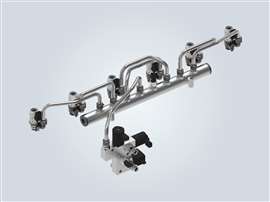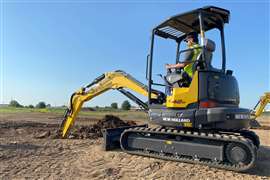Read this article in French German Italian Portuguese Spanish
Liebherr’s Olav Altmann outlines the next stages of fuel injector development
20 May 2025
Details covering Liebherr’s most recent fuel injection solutions for use with conventional and alternative fuels
 Liebherr’s hydrogen-fuel wheel loader prototype (Photo: Liebherr)
Liebherr’s hydrogen-fuel wheel loader prototype (Photo: Liebherr)
Power Progress International: What is the status of your developments in fuel injection solutions for both liquid and gaseous fuels?
Olav Altmann: “Our developments in fuel injection solutions are progressing to meet the diverse engine requirements of both gaseous and liquid alternative fuels. For gaseous fuels, we have made notable advances. We have developed a hydrogen fuel injection system for spark-ignited combustion concepts. Our LPI (low pressure) injector for port fuel injection is already integrated into the hydrogen engine powering the L 566 H wheel loader prototype.
We also offer comprehensive system solutions that include rail and fully-integrated pressure regulators, including all necessary safety functions, as well as an electronic control unit (ECU).
Looking at liquid fuels, such as methanol, ethanol and ammonia, we have developed a solution based on our hydrogen fuel injector. This injector is suitable for both dual- and single-fuel applications; it can be used in single-fuel spark-ignited combustion applications and dual-fuel engines in combination with a conventional fuel injection system. Existing diesel engines can be retrofitted with this tech, or it can be used with redesigned engines. This flexibility allows for a wide range of diesel substitution rates, including 100% diesel operation.
Other features are a stand-alone electrically-driven pump which supports flexible packaging and a separate driver box for integration into existing system environments.
In the case of ammonia, we have received some inquires covering mining applications – ammonia is a low-carbon fuel which has excellent storage properties. The maritime industry in Asia and Europe s looking at methanol as a possible alternative, as are commercial vehicle manufacturers in China and the United States.
 Olav Altmann, Liebherr Components
Olav Altmann, Liebherr Components
PPI: Liebherr Components’ products are used in several different applications. What would you say are the latest trends for the adoption of alternative fuels in marine, power generation, and mobile machinery?
Altmann: “We are monitoring the latest trends for the integration of alternative fuels across various sectors. As just mentioned, methanol is emerging as a prominent alternative fuel in the maritime industry for large engines. Additionally, ammonia is gaining traction, especially for larger low-speed engines.
For mobile machinery and commercial vehicles, hydrogen is increasingly popular. Very low CO2 output makes it an attractive choice for these applications. However, methanol is also gaining interest in this sector due to its versatility and that existing infrastructure can support its use.”
PPI: Liebherr recently launched a new injector for liquid alternative fuels and an electrically-driven fuel pump. What is special about these components and what were the major challenges in the design?
Altmann: “The injector features several key technical aspects. It is a port fuel injector capable of operating at up to 30 bar (435 psi), which is suitable for a range of alternative fuels. The injector is equipped with marine connectors for double-walled pipes, enhancing safety and compliance with maritime standards. It had an adaptable nozzle length and the compact design allows easy packaging within different engine configurations. Each injector can support a flow rate suitable for up to approximately 150 kW per cylinder depending on fuel and application, making it efficient for large engines.
 LIebherr PFI unit for alternative fuels (Photo: Liebherr)
LIebherr PFI unit for alternative fuels (Photo: Liebherr)
The electrically-driven pump is designed to be packaging-independent from the engine design, operating at a pressure of 30 bar and adhering to marine guidelines for low flashpoint fuels. We have conducted successful tests on a hydraulic test bench. The pump is currently designed for use with methanol, testing is already underway. In the future, however, the electrically-driven pump will also be used for other alternative fuels, which will support a wide range of applications.
Development had several challenges, such as selecting appropriate materials and seals to withstand the different chemical properties of alternative fuels. Ensuring durability and reliability under varying operating conditions was critical.”
PPI: Regarding hydrogen applications, do you have reports on the performance of the Liebherr hydrogen wheel loader or the tracked excavator that was launched a couple of years ago?
Altmann: “Based on the latest information, we can share that the hydrogen wheel loader is in regular operation. It matches the performance of comparable diesel-powered machines in the same size range and feedback from operators has been very positive.
The hydrogen excavator also delivers the same overall performance as a diesel counterpart, in terms of power output, engine dynamics and response.”
PPI: What is the performance of these machines in terms of working cycles, manoeuvrability, and autonomy with a full tank? Is there a comparison with the corresponding diesel vehicles?
Altmann: “The hydrogen storage system of the wheel loader is designed to ensure that the tank capacity is sufficient for an entire shift. These hydrogen-powered machines can be operated just like their diesel counterparts, with no significant changes to the usual operating procedures.
Apart from the engine, most of the drivetrain components are sourced from Liebherr XPower wheel loaders.”
PPI: What is your take on the availability of hydrogen fuel for mobile machinery? And what is the status of infrastructure in the EU and other areas?
Altmann: “Currently, the hydrogen infrastructure and fuel availability remains quite limited in Europe and around the world. This, coupled with the absence of comprehensive CO2 emission legislation continues to prevent widespread adoption of hydrogen-based powertrain solutions.
 Rail injection system developed by Liebherr for gaseous fuels (Photo: Liebherr)
Rail injection system developed by Liebherr for gaseous fuels (Photo: Liebherr)
Luckily, the availability of hydrogen fuel for mobile machinery is rapidly evolving, driven by a global focus on hydrogen as a key component of the energy transition.
In Europe, the EU has laid out an ambitious plan to develop a hydrogen economy, which includes significant investments in infrastructure and technology to support hydrogen production, distribution and usage. This plan aims to make hydrogen widely available and economically viable, reducing dependency on purpose-built hydrogen tanking stations. Similarly, other regions are making substantial progress. For example, the government in India is actively funding hydrogen projects, recognizing the potential of enhanced energy security and reduced emissions.
Government funding in China is also driving hydrogen initiatives, with a focus on developing a comprehensive hydrogen supply chain. Japan is establishing its own hydrogen economy, with extensive investments in production and infrastructure.
These global efforts are helping to expand hydrogen infrastructure. As a result, we can expect to see increased accessibility in the near future, making its use with machinery and other applications more practical and widespread.”
This is the full version of the interview which appeared in the January-March 2025 issue of Power Progress International
POWER SOURCING GUIDE
The trusted reference and buyer’s guide for 83 years
The original “desktop search engine,” guiding nearly 10,000 users in more than 90 countries it is the primary reference for specifications and details on all the components that go into engine systems.
Visit Now
STAY CONNECTED




Receive the information you need when you need it through our world-leading magazines, newsletters and daily briefings.
CONNECT WITH THE TEAM












